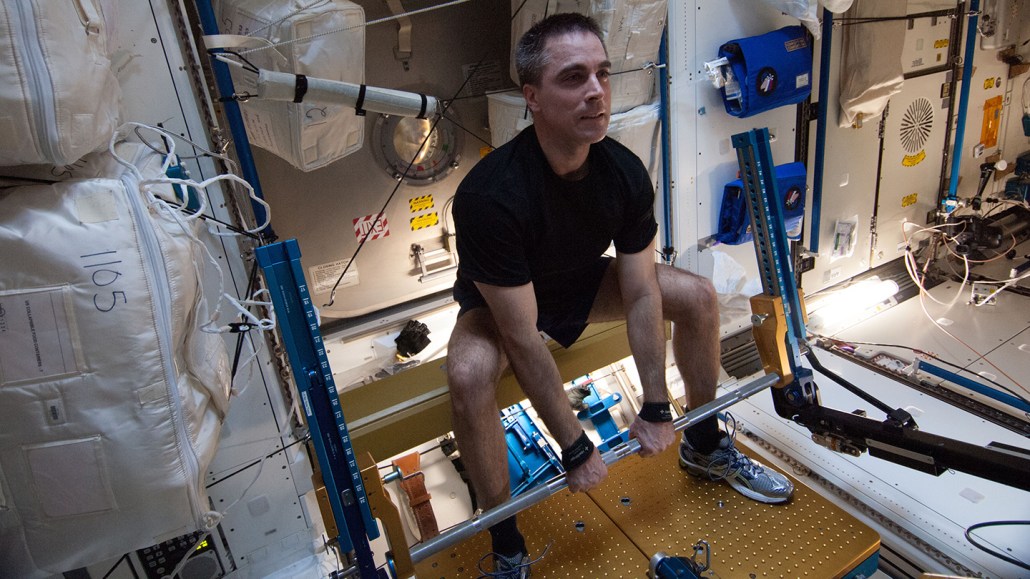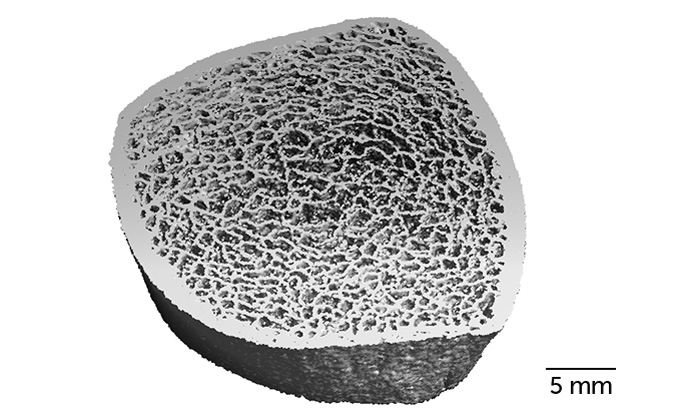Six months in space causes 10 years’ worth of bone loss
Astronauts could help counter changes seen in shinbones with more weight-bearing exercises

NASA astronaut Chris Cassidy performs weight-lifting exercises for leg strength. In space, these help alleviate bone loss due to time spent in a microgravity environment.
NASA
Share this:
- Share via email (Opens in new window) Email
- Click to share on Facebook (Opens in new window) Facebook
- Click to share on X (Opens in new window) X
- Click to share on Pinterest (Opens in new window) Pinterest
- Click to share on Reddit (Opens in new window) Reddit
- Share to Google Classroom (Opens in new window) Google Classroom
- Click to print (Opens in new window) Print
By Liz Kruesi
You might want to bring plenty of exercise gear for your legs on that next trip to space.
During space missions, astronauts can experience a loss of some of the inner structural support in their bones. This leaves those bones less dense than before liftoff. For trips in space lasting at least six months, that bone loss is equal to about 20 years of aging.
The good news: A new study finds that a year back on Earth — and its gravity — rebuilds about half of strength initially lost in the affected bone.
Bones “are a living organ,” notes Leigh Gabel. She’s an exercise scientist at the University of Calgary in Canada. Our bones are also “constantly remodeling,” she points out. But in the microgravity of space, bones will lose some of their strength.
Gabel was part of a team that tracked 17 astronauts. Each of these 14 men and three women had spent from four to seven months in space. The team used a type of computed tomography to measure the 3-D structure of bone on a fine scale. They focused on the structure of the tibia (in the lower leg) and radius bone (in the lower arm). This imaging revealed details on a scale of 61 micrometers. That’s finer than the thickness of a human hair.
The researchers took images of the bones four times — before spaceflight, then when the astronauts returned home from space, and again six months and one year later. From these pictures, Gabel’s team calculated an astronaut’s bone strength and density at each of those times.
Astronauts in space for less than six months regained their preflight bone strength after a year back on Earth. But those who stayed in space longer suffered permanent bone loss in their shinbones, or tibias. That loss was equivalent to a decade of aging. The lower-arm bones, or radii, showed almost no loss. That was likely because these aren’t weight-bearing bones on Earth, Gabel explains. In fact, those arms can get a bigger workout in space than on Earth as astronauts use them to navigate around their craft by pushing off handles and doorways.

Increasing weight-lifting exercises in space could help alleviate bone loss in the legs, says Steven Boyd. He’s also a Calgary exercise scientist. “A whole bunch of struts and beams all held together give your bone its overall strength,” says Boyd. “Those struts or beams are what we lose in spaceflight.” Once these microstructures (called trabeculae) are lost, you can’t rebuild them, he says. You can, however, strengthen the remaining ones. And upon return to Earth’s gravity, the remaining micro-structures did thicken, Gabel’s team found.
While bones can likely survive spaceflight longer than a year or two, Boyd and his co-workers want to know what happens once those bones get back to Earth’s gravity. “The question is,” he says, “Do they turn to jellyfishes?”
“With longer spaceflight, we can expect bigger bone loss — and probably a bigger problem with recovery,” says physiologist Laurence Vico. Not part of the study, she works at the University of Saint-Étienne in France. The new data are especially concerning for long missions, such as a trip to Mars. It would last at least two years. Vico adds that space agencies should also consider other bone health measures, such as nutrition, to reduce bone loss and increase bone formation. “It’s probably a cocktail of countermeasures,” Vico says, that will be needed.
Gabel, Boyd and their colleagues hope to learn more about how bones change after spending even more time in space. As part of a planned NASA project, they will study the effects of a year in space on more than a dozen systems of the body. Says Boyd: “We really hope that people hit a plateau — that they stop losing bone after a while.”







